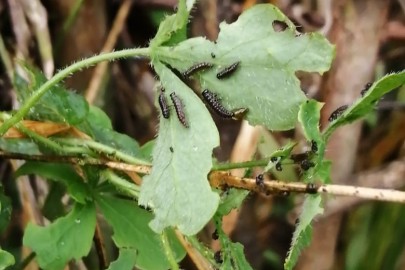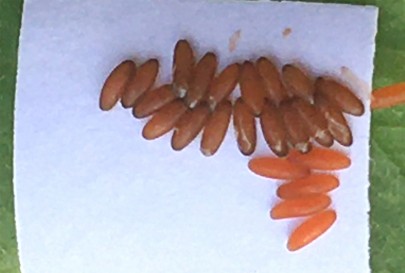Beetling Ahead with Chilean Flame Creeper

Leaf beetle larvae and damage
Hernán was tasked with collecting a starter colony of the beetles to study their biology and requirements for rearing, and to survey Chilean flame creeper populations in the search for other promising natural enemies. Although travel restrictions were implemented in Chile during a second wave of increasing Covid cases, Hernán has made significant progress towards these project objectives.
Eleven sites have been surveyed so far and the leaf beetle was by far the most common natural enemy of Chilean flame creeper in the region that was surveyed. The beetle appears to be confined to low altitudes and can cause extensive damage to the leaves of their host plant. Adults of the leaf beetle were collected at Quintrilpe, in Araucanía in southern Chile, and taken to the laboratory for further study. “These adults laid copious amounts of eggs which all hatched successfully and the beetle larvae consumed impressive quantities of Chilean flame creeper foliage in the lab,” reported Hernán. “The larvae completed development to adults, with the egg to adult life cycle taking about 7 weeks in total.”
Interestingly, Hernán could not find where the adults lay their eggs under natural conditions, so this aspect of the beetle’s life history remains to be discovered when he gets a chance to visit new Chilean flame creeper sites in search of other agents and new populations of the beetle. Hernán is hopeful that site visits at different times of the year will reveal when and where the adult beetles deposit their eggs. Early instar larvae of the beetle were always found on the lower leaves of the vines, near the base of the plants, so it’s possible that eggs are laid in the soil or in the leaf litter. In the lab, the beetles laid eggs on cut foliage and pieces of filter paper.
Another important aspect of the beetle’s biology that Hernán continues to investigate is its overwintering requirements. Preliminary investigations suggest that egg laying is conditional on overwintering. “It will be critical to be able to mimic these conditions for the beetle when we can finally bring them into containment in New Zealand for host range testing,” explained Ronny Groenteman, who is leading the project. “Successful rearing in the laboratory can be crucial to a successful biocontrol project,” she added.

Leaf beetle eggs in the laboratory
In addition to the leaf-feeding beetle, eggs and caterpillars of a moth were found on Chilean flame creeper during the surveys. The caterpillars were reared to adulthood in the laboratory and were identified as belonging to the microlepidopteran family Plutellidae, commonly known as the diamondback moths. Hernán will need to investigate this moth further before we know whether it is worth pursuing as a candidate biocontrol agent.
Chilean flame creeper is a rare plant in its native range, confined to the coastal areas of southern Chile up to 1,000 m above sea level. The plant’s rarity and limited distribution in Chile make it fairly challenging for Hernán to find sites to survey. However, the extensive damage caused by the first agent prioritised for biocontrol of Chilean flame creeper gives us great confidence that this could be an effective tool to tame infestations in New Zealand.
This project is jointly funded by the National Biocontrol Collective and the Ministry for Primary Industries’ Sustainable Food and Fibre Futures Fund (Grant #20095) on multi-weed biocontrol.
